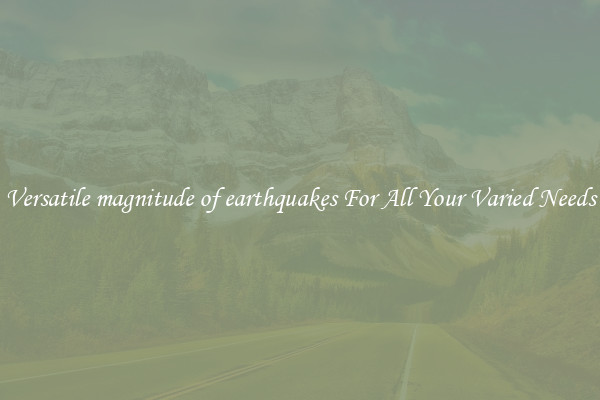Versatile magnitude of earthquakes For All Your Varied Needs
When it comes to earthquakes, magnitude is a crucial factor to consider. It not only helps us understand the strength and intensity of the quake, but also assists in preparing ourselves for potential damage and loss. The versatile magnitude scale of earthquakes allows us to assess the varying needs that different regions and structures might have, ensuring a more comprehensive approach to earthquake preparedness and response.

The most commonly used magnitude scale is the Richter scale. Developed by seismologist Charles F. Richter in 1935, this scale measures the amplitude of seismic waves recorded by seismographs. It is a logarithmic scale, meaning that each unit increase represents a tenfold increase in the amplitude of the waves. For example, an earthquake measuring 5 on the Richter scale is ten times stronger than an earthquake measuring 4.
The versatility of the magnitude scale lies in its ability to adapt to various scenarios and structures. For instance, when assessing the magnitude of an earthquake that occurs in a densely populated urban area, other factors such as building infrastructure and population density come into play. In such cases, the moment magnitude scale (Mw) is often used. This scale incorporates additional data and provides a more accurate measure of the earthquake's energy release.
Another consideration in assessing the magnitude of earthquakes is the specific needs of different infrastructures. For example, the Modified Mercalli Intensity (MMI) scale takes into account the impact of an earthquake on human structures and activities. It rates the shaking felt at a specific location, ranging from I (not felt) to XII (total destruction). This scale helps in determining the potential damage to buildings, bridges, and other structures, enabling engineers and architects to design and construct more resilient structures in earthquake-prone areas.
The versatile magnitude scales also assist in categorizing earthquakes based on their potential to cause damage. For instance, the Moment Magnitude Scale distinguishes between small, moderate, and large earthquakes, helping to prioritize resources and response efforts. By having a clear understanding of the earthquake's magnitude, authorities can allocate appropriate funds and emergency services to affected areas, ensuring a more efficient and effective response.
Furthermore, understanding the versatile magnitude scales of earthquakes is crucial for earthquake-prone regions in terms of preparedness and response plans. By knowing the magnitude, authorities can determine the best course of action, from evacuation plans to the deployment of emergency services. Public awareness campaigns can also be tailored to specific magnitudes, educating communities about the expected impacts and necessary precautions.
In conclusion, the versatile magnitude scales of earthquakes are essential tools for understanding the strength, intensity, and potential impacts of seismic events. By accurately assessing the magnitude, we can better prepare ourselves, design resilient structures, and allocate resources effectively. Whether it is the Richter scale, the moment magnitude scale, or the Modified Mercalli Intensity scale, understanding these magnitudes ensures that our varied needs are met when it comes to earthquake preparedness and response.

View details

View details

View details

View details








